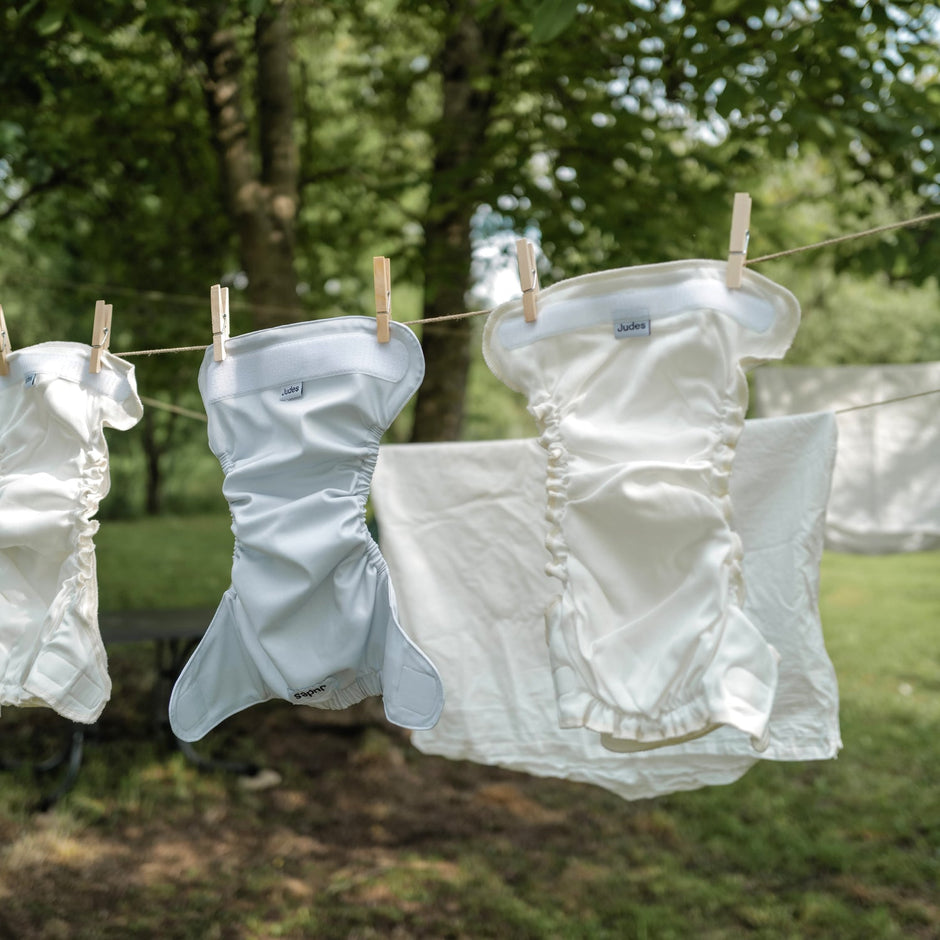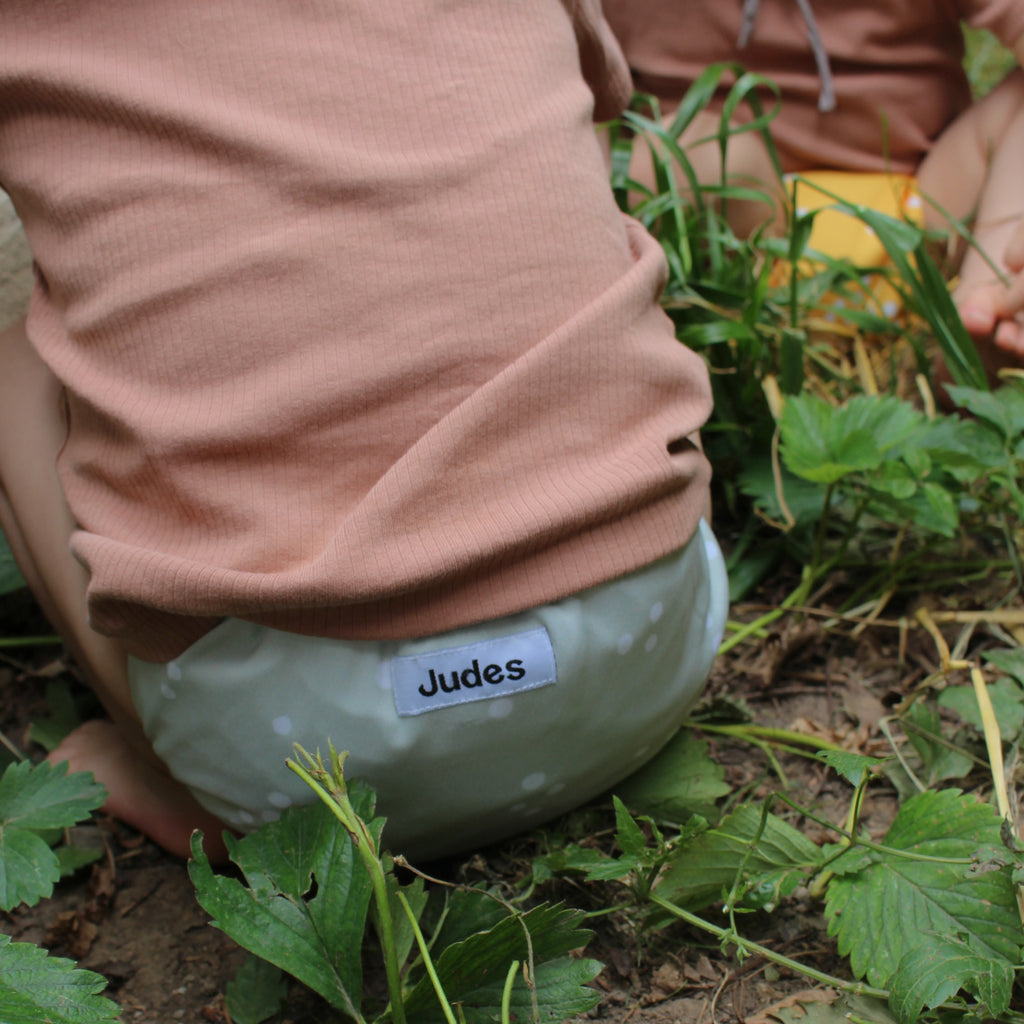How to Gently and Hygienically Wash Your Cloth Diapers
Updated on:
Photo by @isabelplett
The basic idea behind cloth diapers is that they are reusable and counteract a generation of waste. To reuse the used diapers, they are washed. The diaper laundry is probably the biggest concern for newcomers, as many still associate it with hand washing and boiling. However, washing cloth diapers nowadays is incredibly easy, thanks in no small part to our modern washing machines and highly effective detergents. Diaper laundry now takes little time. In fact, compared to disposable diapers, you can even save time with cloth diapers.
How often should cloth diapers be washed? Used cloth diapers must be washed by the fourth day of storage at the latest. This results in electricity and water costs of about 6,00 to 8,00€ per month.
In the following article, we have compiled a clear guide for washing cloth diapers. Moreover, you will learn which detergent is best to use and which mistakes you should avoid. By the end of this post, you will see that washing cloth diapers is indeed simple.
Basic Principles of Cloth Diaper Washing
Besides the right detergent and appropriate washing program, there are a few things you should consider before washing. Apart from the following sections, before washing cloth diapers, you should take into account these little things:
- From the time your child starts on solid foods, their stool is no longer water-soluble and ideally should not end up in the washing machine. If you now think that you have to hand wash each diaper, we have good news: There's an alternative! The use of diaper liners, such as our Poo Paper, greatly simplifies the process. It lies as the topmost layer in the diaper. If it comes into contact with stool, it goes to the trash, along with the waste.
- To achieve the best washing results, you should separate inserts like prefolds, muslin diapers, or boosters from the covers. Note: With our diapers, the inserts are already sewn in, so they can go into the machine as they are.
- To gently wash PUL covers, it is recommended to use a wash bag. Holes in the PUL (PUL is the layer that creates the water barrier) can lead to the cover no longer being leak-proof. Note: We've also developed an innovative solution that allows our covers to be washed without a wash bag.
- Hook-and-loop fasteners should not be loose in the washing machine. Usually, diapers have a counter hook-and-loop. This ensures that other fabrics are not damaged by the hook-and-loop.
Proper Storage
One of the myths about cloth diapers is that you can smell the stored diapers throughout the house. However, with proper storage, this is not the case at all. It is important that diapers are stored in a way that is odor-proof, yet still breathable. The more oxygen that reaches the diapers, the less ammonia is produced and the less the diapers are strained. Additionally, steady moisture should be avoided, so do not add washed-out diapers or very wet washcloths to the pile. Too much moisture promotes the growth of mold. But don't worry: as you will soon see, we have developed a solution that guarantees successful storage. Essentially, there are two methods for storing cloth diapers:
1. Diaper Bags
Diaper bags, also known as wet bags, are usually made of PUL and are water-repellent, breathable, and odor-proof. Our diaper bag has a handy hanging feature and a zipper on the bottom side. This allows for a hygienic washing process because it can be placed in the washing machine along with the diapers.
Here's how it works: Put the diaper bag in the washing machine, open the zipper and start the washing cycle. Due to the motion of the washing machine, the cloth diapers will fall out of the bag on their own, so you won't have to come into contact with the soiled diapers.
2. Diaper Pail
An alternative to the hanging diaper bag is a standing diaper pail. This is particularly odor-proof and can often be operated with the foot. Therefore, you can use it one-handed, always keeping one hand on your child. Inside the diaper pail, there is either a diaper bag or a pail liner. Many cloth diaper users alternatively use old pillowcases for storing diapers. To minimize odor formation, it is important that the diaper pail is not completely sealed. This is because less ammonia is produced with the presence of oxygen.
The Right Washing Rhythm
It is recommended not to store used cloth diapers for longer than four days. This interval makes sense for the following reasons:
- With no air circulation, the components of urine begin to break down, and ammonia is produced. This damages the material of the cloth diapers and can become entrenched in them. Once this happens, it can lead to unpleasant skin irritations and special cleaning becomes necessary.
- The longer stains are allowed to remain in the cloth diapers, the harder they are to remove.
- Longer storage encourages the growth of bacteria.
If your diaper laundry does not fill a washing machine after four days, you can easily add more laundry. It's just important that it is suitable for 60°C, which includes items such as towels or bed linen.

Cloth Diaper Laundry – Which Washing Program is the Correct One?
We have designed our diapers to be as easy to wash as possible. Therefore, for our diapers: All the following tips do not necessarily need to be considered when you’re using our cloth diapers.
But back to the topic: Have you ever heard of the washing formula? The so-called "Sinner's Circle" has proven itself for decades, representing the influence of four factors on the cleaning result:
- Mechanical action, that is, the turning of the laundry drum and the rubbing of the laundry against each other
- Chemistry, meaning the detergent
- Temperature
- Time, meaning the duration of exposure
With the addition of water, these individual factors become effective. The best cleaning result is achieved when you optimally adjust each parameter to one another. The following settings are necessary if you want to wash your cloth diapers hygienically.
Pre-wash
It is advisable to run a pre-wash cycle before the main wash program. It is important that your machine pumps out the water after the pre-wash. This has several advantages. For one, both urine and stool residues are largely flushed out. In addition, the fabric fibers are soaked, making it easier for dirt to be released from the fibers.
Cotton and Colored Laundry
For absorbent inserts, the Cotton or Boil Wash program is suitable. Especially multi-layered absorbent material should be thoroughly agitated for proper cleaning, which is often not the case with other programs.
So that the diapers move well in the machine, you should not overfill it. A good rule of thumb is to leave the width of a hand's space.
Temperature
Cloth diapers should be washed at 60 °C for hygienic cleaning. High-quality PUL can withstand these temperatures but can also be added to a 30 °C to 40 °C colored laundry cycle.
Spinning
When washing cloth diapers, you should reduce the spin speed to 800 to 1,000 revolutions per minute. This not only saves energy but also prevents unnecessary wear and tear on the fabric. Nevertheless, this movement is sufficient for the diapers to dry quickly afterward.
Hand Washing
Some materials require hand washing for proper care. This especially includes cloth diapers made of wool and silk. Hand washing should be done at a maximum of 40 °C with plenty of water and little movement. With a suitable and gentle detergent, you can wash your wool diapers by hand and then rinse them thoroughly.
Some modern washing machines have a program that simulates hand washing. In this setting, the drum only moves gently back and forth instead of making full rotations.
This article covers the washing of cloth diapers. For the optimal care of wool diapers, you should seek additional information separately!
Which Detergent Should I Use for Cloth Diapers?
The topic of detergents is probably of most concern to those new to cloth diapers, as there are many ingredients to consider. The following criteria should be met:
- It contains no chlorine bleach: With frequent use, this can attack the fibers of your diapers and damage the PUL.
- It contains no fabric softener: This clogs the fibers and thus reduces the absorbency of your diapers.
- It contains no fragrances: These could irritate your baby's skin or even cause an allergic reaction.
- It contains no optical brighteners or preservatives: While these are neither harmful to the diapers nor to the baby, they are difficult for nature to decompose.
Nowadays, there are special detergents that have been specifically formulated for the needs of cloth diapers. With Judes Family Care, washing cloth diapers becomes easier, more sustainable, and gentler.
- It is designed to wash out residues particularly easily.
- It consists of especially environmentally friendly ingredients.
- It is skin-friendly - even for delicate baby skin.
- It is “Made in Germany” and fragrance-free.
- It comes in a practical three-month pack (2.475kg).
Our detergent is also excellent for gently and thoroughly cleaning children's and baby clothing.
Alternatively, you can opt for a universal detergent from the drugstore. Primarily, sensitive detergents that contain neither fragrances nor perfumes are suitable. Ideally, the detergent already contains oxygen bleach, as this kills possible bacteria and supports stain removal. If it does not contain oxygen bleach, you can also add it separately.
Important: When washing cloth diapers, you should use detergent sparingly. Usually, half the recommended amount is sufficient for hygienic washing of your cloth diapers. You should definitely avoid overdosing, as this can leave detergent residues, making the diapers hard and potentially irritating your baby's skin.

Photo by @jessicadelanour
How Do I Dry My Cloth Diapers After Washing?
Generally, most cloth diapers and inserts are suitable for dryer use. However, you should adhere strictly to the manufacturer's recommendation and use the dryer only on a gentle setting. PUL covers and diaper bags, like wool and silk, should not go in the dryer. Cotton, on the other hand, is considered robust. Our diapers are designed to be safely dried in the dryer.
Line drying is more environmentally friendly and also saves energy and electricity. It also preserves the fibers of the cloth diapers, considerably slowing down wear and tear. Inserts and diapers usually take about one to two days to dry on the line. If you have the opportunity to set them in the sun, it may only take 20 minutes. Seen in this light, diaper laundry hardly differs from the usual laundry routine. After a few loads, you will see that washing cloth diapers is neither complicated nor does it take more time than the rest of the laundry.
Line drying tends to make the diaper laundry somewhat stiff. This in no way diminishes the function and doesn't bother most children. If you prefer your laundry to be softer, you can knead them once or pull them over an edge after drying. Wind during line drying generally leads to softer laundry.
It's important in any case to ensure that the absorbent material contains no residual moisture after drying, as this can lead to bacterial contamination.
It should be noted that wool products need to be dried horizontally, for example on a towel. Hanging them on the line would cause the sensitive fabric to lose its shape.
Summary of Washing Instructions
- Properly prepare the laundry
- Always choose a full wash cycle with a pre-wash
- Set the washing temperature to 60°C
- Use cloth diaper detergent, or alternatively a universal detergent with oxygen bleach
- Avoid fabric softeners, optical brighteners, and other additives
- Set the washing machine spin rate to 800 to 1,000 RPM
- Dry as desired and based on material in the dryer or on the line

Photo by @olivia_greige
Useful Tips and Knowledge on Washing Cloth Diapers
Priming the Absorbent Material
In general, you should wash any textile products at least once at a minimum of 30°C before first use to remove any manufacturing residues.
For the absorbent material to reach its full absorbency, it needs to be washed multiple times. To avoid unnecessary energy and water costs, you can wash the diapers with your regular laundry, ensuring that you still use the correct detergent. This priming process includes allowing the fabrics to thoroughly dry between washes. It is also good to know that many absorbent materials shrink slightly when washed.
You can start using the diapers after the first wash, just be aware that they will not have reached their full absorbency yet and therefore will need to be changed more frequently. With our diapers, full absorbency is typically achieved after about the 6th wash.
Stripping Cloth Diapers – When Your Diapers Need a Deep Cleaning
If your child's skin is frequently irritated, the diapers start to smell, or fluids are not being absorbed as well, a deep cleaning of the diapers can help. Depending on the cause, various methods may be necessary. To remove any possible residues in the cloth diapers, a bath in lactic acid can help. Soak the freshly washed diapers for at least three hours in a bath of water and lactic acid or diluted citric acid. Afterwards, wash them again as usual.
An alternative is a washing cycle at 90°C.
Stain Treatment
Stains in cloth diapers are not an indication of insufficient cleaning performance. Often, they disappear on their own after several washes. However, a simple method to guarantee stain removal is to lay the diaper in the sun. Feces stains are actually not fecal matter residues, but rather should be understood as a dye. The stains, including those from breast milk feces, contain bilirubin, which decomposes in sunlight. So, just lay the cloth diapers out in the sun for a short time and the stains disappear as if by magic. This also works without direct sunlight, which can help protect PUL and wool.
Other means of treating stubborn stains include stain soap or gall soap as well as ecologically safe stain sprays. Stains on wool diapers can often be removed with just a damp cloth, or alternatively, you can soak them in cold water and treat the stains with olive pit soap.
Secret Tip
Adding a splash of descaler to your diaper laundry increases the wash performance and saves effectively on detergent. Moreover, the diapers remain soft and the absorbency is enhanced. The descaler from Ulrich naturally is even suitable as a fabric softener replacement due to its composition, as it contains neither chemicals nor unnecessary additives.

Photo by @oneeggtwokids
Common Mistakes in Diaper Washing and Their Solutions
Cloth Diapers Begin to Smell
If you notice a foul odor, the first thing you should do is check your washing and storage routine. If your baby is teething and drinking less, their elimination patterns can change, and you should reduce the time between washes.
In these cases, you should also ensure the addition of oxygen bleach and store the diapers as airy as possible between washes.
Detergent Residues
If detergent residues cannot be attributed to using too much detergent, you can add 30 ml of lactic acid to the fabric softener compartment. This neutralizes the residues and additionally softens the laundry. Alternatively, a bath in lactic acid or citric acid can help.
Inserts Absorb Less Fluid / Diapers Are Not Leak-Proof
One reason your inserts might be absorbing less fluid (not being leak-proof) could be that they are not sufficiently primed. In this case, the problem should resolve itself after a few washes. Otherwise, particularly with microfiber, it could be that the inserts have become soapy. To remove the build-up, you can soak the diapers briefly in dish soap water and then wash them as usual.
PUL Covers Are Leaking
If PUL covers are leaking, it is usually because the material is damaged. In this case, the only remedy is inserts that have an integrated PUL layer to prevent leaks. Causes for damage to the PUL fabric can include:
- severe temperature fluctuations
- mechanical wear and tear
For this reason, PUL items should not be dried in the dryer or in extreme cold. High spin cycles, sharp-edged laundry items, and open hook-and-loop fasteners can also damage the material of your diapers. If none of these causes apply, a claim with the manufacturer may be in order.
We have designed our covers so that the PUL layer is on the inside, protected from external influences. This leads to them being especially durable - even with the use of a dryer - while maintaining their high quality.
The Washing Machine Smells
No worries: This is a general problem (regardless of cloth diapers) and it only happens very rarely. Nevertheless, we want to address this issue.
The main cause of odors is usually bacteria or mold in the washing machine. They cling to the drum, detergent compartment, and rubber seals due to low washing temperatures and short programs. The lint filter and the inlet hose are also ideal breeding grounds for bacteria. These places should definitely be checked during cleaning.
Regular 60-degree wash cycles combined with bleach largely eliminate bacteria. However, cleaning the washing machine can still be beneficial. The following environmentally-friendly methods are suitable:
- Cleaning with citric acid or vinegar
- Cleaning with baking soda
- Cleaning individual parts in the dishwasher and boiling water for the detergent compartment

Photo by @isabelplett
Energy and Water Consumption – The Cost of Washing Cloth Diapers
One of the main arguments against the use of cloth diapers is the supposedly high cost of energy and water. For this, we have put together a calculation:
Let's assume you diaper your child for about three years and wash the cloth diapers three times a week. This is actually a high estimate; with our diapers, it is sufficient to wash every four days. You use a modern average washing machine and a conventional detergent. This results in the following electricity and water consumption:
| 1 Wash cycle | 1 Year | 3 Years | |
| Electricity | 0.9 kWh | 110 kWh | 328.5 kWh |
| Water | 44 Liters | 5353 Liters | 16,060 Liters |
For illustration:
The annual electricity consumption is equivalent to about 100 times baking.
The annual water consumption is approximately equivalent to 60 showers.
Costs with a washing rhythm of three days
| 1 Wash cycle | 1 Year | 3 Years | |
| Electricity | 0.27 € | 33.32 € | 99.96 € |
| Fresh/ Waste Water | 0.19 € | 23.13 € | 69.38 € |
| Laundry Detergent | 0.13 € | 15.82 € | 47.45 € |
| Wear and Tear of Washing Machine | 0.19 € | 23.14 € | 69.43 € |
| TOTAL | 0.78 € | 95.41 € | 286.22 € |
So, cloth diapers account for about 4 to 5 percent of your total consumption. The costs are about half as much as you would spend on disposables' accessories alone (e.g., wet wipes). By adjusting the number of diapers, you can reduce the frequency of washing. Additionally, depending on the diaper system, you have the option to wash some parts with your regular colored laundry.
Conclusion
Hygienically washing cloth diapers is not a daunting task and is basically similar to your usual laundry routine. Clever and ever-evolving systems ensure easy processes. The diapers from Judes Family, for example, are designed so that all components can be washed uncomplicatedly at 60°C and dried in the dryer. Combined with the practical diaper bag, diaper laundry becomes child's play. Additionally, the stylish diapers from Judes are particularly easy to use, making them ideal for newcomers.
If you pay attention to and internalize a few fundamentals, you will quickly find great joy in the environmentally friendly alternative to disposable diapers.
Do you have questions or comments about washing cloth diapers? Feel free to leave a comment!

